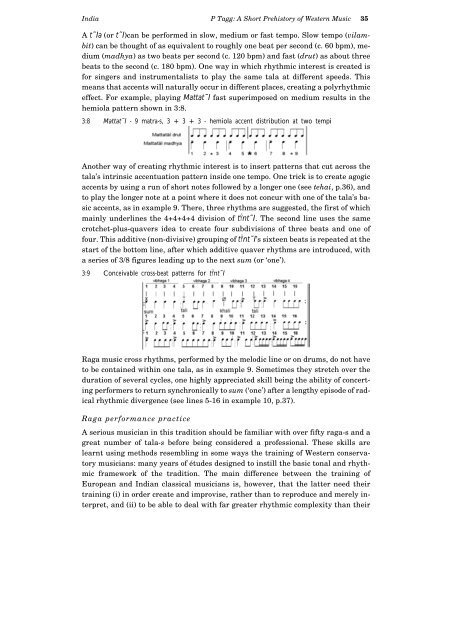A Short Prehistory of Western Music, Chapter 3
A Short Prehistory of Western Music, Chapter 3
A Short Prehistory of Western Music, Chapter 3
Create successful ePaper yourself
Turn your PDF publications into a flip-book with our unique Google optimized e-Paper software.
India P Tagg: A <strong>Short</strong> <strong>Prehistory</strong> <strong>of</strong> <strong>Western</strong> <strong>Music</strong> 35<br />
A t˜la (or t˜l)can be performed in slow, medium or fast tempo. Slow tempo (vilambit)<br />
can be thought <strong>of</strong> as equivalent to roughly one beat per second (c. 60 bpm), medium<br />
(madhya) as two beats per second (c. 120 bpm) and fast (drut) as about three<br />
beats to the second (c. 180 bpm). One way in which rhythmic interest is created is<br />
for singers and instrumentalists to play the same tala at different speeds. This<br />
means that accents will naturally occur in different places, creating a polyrhythmic<br />
effect. For example, playing Mattat˜l fast superimposed on medium results in the<br />
hemiola pattern shown in 3:8.<br />
3:8 Mattat˜l - 9 matra-s, 3 + 3 + 3 - hemiola accent distribution at two tempi<br />
Another way <strong>of</strong> creating rhythmic interest is to insert patterns that cut across the<br />
tala’s intrinsic accentuation pattern inside one tempo. One trick is to create agogic<br />
accents by using a run <strong>of</strong> short notes followed by a longer one (see tehai, p.36), and<br />
to play the longer note at a point where it does not concur with one <strong>of</strong> the tala’s basic<br />
accents, as in example 9. There, three rhythms are suggested, the first <strong>of</strong> which<br />
mainly underlines the 4+4+4+4 division <strong>of</strong> tŸnt˜l. The second line uses the same<br />
crotchet-plus-quavers idea to create four subdivisions <strong>of</strong> three beats and one <strong>of</strong><br />
four. This additive (non-divisive) grouping <strong>of</strong> tŸnt˜l’s sixteen beats is repeated at the<br />
start <strong>of</strong> the bottom line, after which additive quaver rhythms are introduced, with<br />
a series <strong>of</strong> 3/8 figures leading up to the next sum (or ‘one’).<br />
3:9 Conceivable cross-beat patterns for tŸnt˜l<br />
Raga music cross rhythms, performed by the melodic line or on drums, do not have<br />
to be contained within one tala, as in example 9. Sometimes they stretch over the<br />
duration <strong>of</strong> several cycles, one highly appreciated skill being the ability <strong>of</strong> concerting<br />
performers to return synchronically to sum (‘one’) after a lengthy episode <strong>of</strong> radical<br />
rhythmic divergence (see lines 5-16 in example 10, p.37).<br />
Raga performance practice<br />
A serious musician in this tradition should be familiar with over fifty raga-s and a<br />
great number <strong>of</strong> tala-s before being considered a pr<strong>of</strong>essional. These skills are<br />
learnt using methods resembling in some ways the training <strong>of</strong> <strong>Western</strong> conservatory<br />
musicians: many years <strong>of</strong> études designed to instill the basic tonal and rhythmic<br />
framework <strong>of</strong> the tradition. The main difference between the training <strong>of</strong><br />
European and Indian classical musicians is, however, that the latter need their<br />
training (i) in order create and improvise, rather than to reproduce and merely interpret,<br />
and (ii) to be able to deal with far greater rhythmic complexity than their














